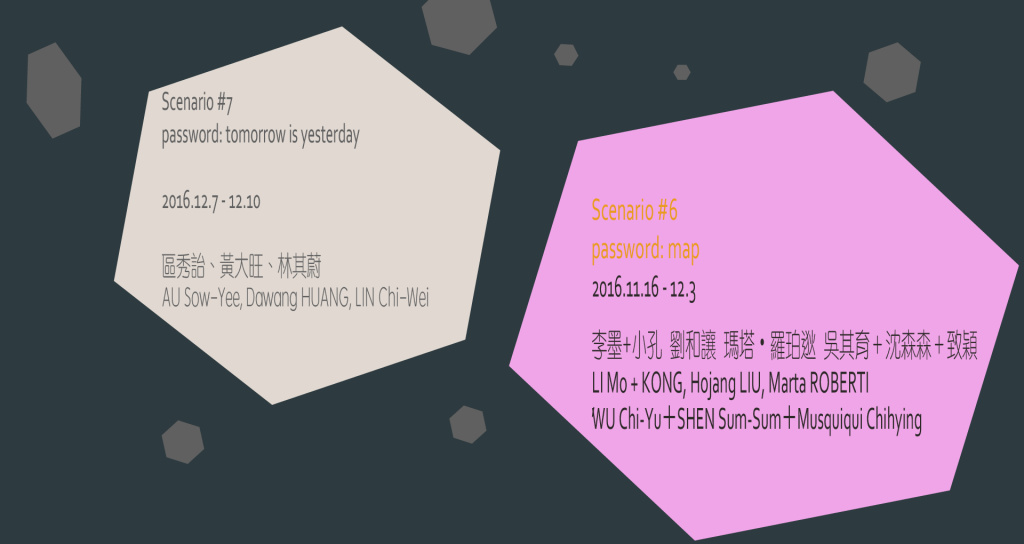 For English, please scroll down.
For English, please scroll down.
我們需要退化以四肢爬伏,與歷史之鱷同行。
《肖像擺》場景六所進行的拓撲,連接著數個時間點與地點的亞洲;它並非是對於(亞洲)現代性的全景式製圖,以呈現「現代亞洲」是在如何的力量與技術中被繪製出來;相反地,它試圖透過施展不同維度間的投影、轉換、推擠與拉扯,呈現在多歧的現代性之間如何流動與跨越。
穿梭在《梭羅河的歌》三個不同年代的不同變體之間,《聲線計畫:梭羅河的歌》(吳其育+沈森森+致穎)以廣播劇的形式橋接了三段在截然不同政治時空與社會壓力中的愛情敘事,揉雜著《梭羅河的歌》(1951)日本軍國主義亞洲的失利、《花團錦簇》(1963)歐洲殖民現代性所塑造的無國界、《梭羅河的歌》(1971)冷戰美國勢力急遽擴張與其文化殖民的動勢,可見其背後三種不同殖民力量在戰後亞洲之中的消長,它們在亞洲現代性中交替與融混著,成為一個新的滾動力量。而在這個重塑之間,藝術家摺曲了這個現代性的亞洲區域地景,投放到一種當代屬於全球性的時間感之中。
李墨與小孔描繪下的長辛店,是一個被中國現代性所驅趕的城,它在技術現代性(蒸汽火車)、政治現代性(無產階級革命)的掙扎與衝突中捏塑人與街廓的面容。他們所做的並不是地理的測繪,而是關於歷史、記憶與述說者的重新製圖。劉和讓的作品透過一個勞動微觀地景的測量與描繪,帶動一個勞動者、測繪者與器物、物質之間的翻轉關係。兩者呈現的都是勞動與物質之間那種不可交易卻可彼此形變的相位,那雕塑、擠壓、一再模塑的動態過程。
如何將既有權力所編繪的地圖予以翻褶?在瑪塔・羅珀逖《這時候很奇怪,而詭譎的事也正在發生》作品部分裡,她運用了來自於「台博會」(始政四十週年紀念台灣博覽會)一張國防館裡的女降落傘員的攝影,這場本來是用以展示軍國主義與殖民成果的嘉年華。這張1935年的攝影透露著在台博會這樣的殖民結構中,台灣如何被配置到一個訴說統治者全球性形象的結構裡,在其中臣屬,亦在臣屬中「現代化」。然而,瑪塔・羅珀逖進行了一層虛造:她將其中降落傘軍裝轉變為傳統和服,而誕生了一個後歷史(或超歷史)的意義:當然,一方面,軍國皇權的需要透過一種更為假造與絕然美的崇高形象來展示自身的威權,那無可企及的絕對力量。然而在這裡,降落傘與和服的褶,成為帝國權力在進入地方的褶子,它顯現巨大權力進入在地時,需要的分流、迴路、曲線與褶疊;從和服女子穿著降落傘的降落,帝國式形象正式進入了柔性的在地情感動員。在此,身體、權力彼此相互覆蓋、平面化,彼此翻褶。
李墨+小孔
行動作為生產模式,是為書寫建築工作室的建築師李墨和小孔所致力在思考與探索介於理論思辨與建造技藝之間的可能。透過公共性計劃促進社群對於居所空間進行關注、思考、對話與實驗,以樹立新價值導向的邊緣方法以及建構新生產模式的在地投放,輸出具書寫意涵的當代城市設計。目前工作與生活於北京。
劉和讓
在劉和讓的透視下,其創作並非僅僅涉及影像自身或技術操作問題,其藝術實踐方式往往映照出對象物相屬之社會關係和政治性意義;一個物件、地方、社群的顯影是在勞動、時間總總因素的疊置下展現獨一無二的特殊和差異性。藉由挪動可見與不可見的關係,他對藝術的社會機能、感知介質鋪陳了新的想像,將聯繫在人與人之間的無形價值代換出來,成為藝術持續的動力。目前工作與生活於台北。
瑪塔・羅珀逖
遊移於詩意圖像與哲理思辯之間,在瑪塔‧羅珀逖的繪畫裝置與手繪動畫中,探討關於西方文化主體位置與其對位文化之間的交結定義,尤其關注於動物、自然以及異國東方之脈絡。往往可見其作品中循線而遁出的晦澀微型,通過對自然與人為之間的擺盪對話,期以提出另類具象的表達以一探人類所在與其所使用於再現自我的語言之間的歧異。目前工作與生活於羅馬。
吳其育+沈森森+致穎
吳其育的創作往往透過口述歷史與傳說的紀錄與再製,並在敘事的解構與重構過程中,重新連結歷史紋理與生活場域斷裂的後現代人類文明。其目前工作與生活於台北。沈森森的創作則關注於聽覺所能引發的其他想像或感知,亦善於就意義上處理聲音本身所具備的符號及敘事性。其目前工作與生活於柏林。而藉著探討人和公共空間的相互關聯,致穎的創作所聚焦的美學命題則是關於資本如何改變人類生活習慣及作息。其目前工作與生活於台北與柏林。聲線計劃為此三位藝術家共同合作的創作項目。
We need to degenerate and crawl on our limbs to accompany the giant crocodile of history.
Scenario #6 of Portrait Portrait could be seen as a topological attempt to connect several periods and spaces in Asia. Instead of a panorama that reveals the powers and technologies delineating Asian modernity, it draws out the flow and the leaps of contestation via different projections, transformations, pushes and pulls to ask “How can we reshape the cartographic processes imposed by the existing powers?’
Sound Route: Bengawan Solo (Wu Chi-Yu+Shen Sum-Sum+Musquiqui Chihying) employs a song that passed through three eras. Its different adaptations bring three romantic cinema stories from various political backgrounds with their respective social and cultural pressures together in a narrated radio play. Bengawan Solo (1953) talks about the failure of Japanese Militarism in Asia; Love Parade (1963) addresses the boundless modernity shaped by European colonization; while Bengawan Solo (1971) outlines US power in Asia and the ongoing effects of cultural colonialization in the post-Cold War era. The project contemplates how different colonial powers intertwined into a new hybrid force to shape Asian modernization, and how artists unfold the geopolitical landscape to seek the contemporaneity that belongs to a global sense of time.
Chang Xin Dian is a city driven by Chinese modernization in Li Mo & Kong’s narration, struggling with the confrontation of modern technology of the trainline and the equally modern politics of the proletarian revolution. They present a contour of the expressions of people and streets to remap history, through memories and their storytellers instead of geography. Liu Hojang’s project flips the relation between the measurement of subject and object, objecthood and materiality, through microscopic analysis. Both projects demonstrate the untradeable but inter-exchangeable positions—the motion process as means for sculpture.
In Marta Roberti’s These time are strange and strange things are happening , she adapts a photographic image of a female parachutist from The Grand Sight of Formosa Exhibition for the Commemoration of the 40th Year of Its Foundation Under Japanese Rule, which manifested the militarism and colonization as a carnival. This photograph from 1935 was intended as a global image of Taiwan’s role in the narrative of modernization of its colonial ruler. Roberti plays a fictional twist: she changes the military uniform into a traditional kimono with post (or hyper) historical connotations. The Japanese Emperor’s authority acquires an artificial, yet absolutely sublime image to accompany its unchallengeable power. However, the meeting of parachute and kimono folds into a critical niche to represent how colonial power enters the local. The symbol of the landing female parachutist in kimono exactly addresses the soft mobilization of affection for the empire, and reveals the dialogues of body and power in different kinds of covering and folding actions.
LI Mo & KONG
LI Mo & KONG studies the connection between theoretical speculation and architectural techniques. The studio explores new horizons for urban design and its related art through “Calligraphic” interpretations. Their public projects, brings the community attention, thinking, conversations and experiments to build up the margin method which leads a new set of values formed within and the local launch of a new production pattern constructed at a locale. Calligraphy Architecture Studio is based in Beijing.
Hojang LIU
Hojang Liu’s works and projects extend beyond questions of image-making or technology quality. His peculiar artistic practice exposes the social context and politics behind the surface. Be it via an object, a place, or a community, his works shed light on their peculiarities and differences. In this relation between the visible and the invisible, he articulates an authentic narrative to the social functions and sensibility of art to transform the values of human networks. And, in turn, employs these forces to sustain art production. Liu lives and works in Taipei.
Marta ROBERTI
Marta Roberti’s poetic imagery and speculative philosophy are articulated through hand-drawn installations and animations that investigate how Western culture relates to what defines other and opposite to itself: in particular the animal, the nature and the east felt like exotic. A miniature of gloomy darkness can be seen in her work applied through the vague dialogue between the nature and the artificial, in order to provide alternative figures to express the contradictions between what we have become and the language we use to represent ourselves. Roberti lives and works in Rome.
WU Chi-Yu+SHEN Sum-Sum+Musquiqui Chihying
Sound Route is a collaboration between Wu, Shen and Musquiqui Chihying.
WU Chi-Yu’s practice focuses on the recording and reproduction of oral histories and local rumour. Through the process of deconstructing and reconstructing these narratives, he aims to reconnect with a post-modern society which has become detached from history and community. Wu lives and works in Taipei. SHEN Sum-Sum’s interests lie in how imagination and perception is evoked by the experience of listening through the symbolic and narrative character of sound itself. Shen lives and works in Berlin. Musquiqui Chihying focuses on the relationship between the human body and the public domain, as well as how capital production twists everyday routine. Musquiqui Chihying lives and works between Taipei and Berlin.
